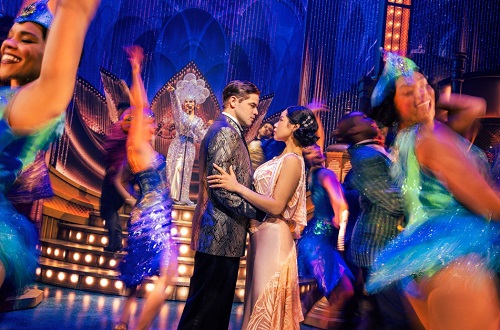The Citiblog
The Great Gatsby Believes Excess Equals Success
April 25, 2024, 10:32.40 pm ET

Photo: Murphy/Zimmerman
By Brian Scott Lipton
Just as Jay Gatsby, the millionaire at the center of F. Scott Fitzgerald classic novel “The Great Gatsby,” believes that an excessive show of wealth signals that he’s made it in 1920’s Long Island society, so do the creators of this overly elaborate, painfully overwritten and ridiculously over-sung musical adaptation of the novella, now at the Broadway Theatre (after an earlier run at Paper Mill Theatre in New Jersey).
Admittedly, in terms of customer satisfaction, they may be right. Audiences are sure to be dazzled by Paul Tate DePoo III’s magnificent, jaw-dropping scenic design – especially for Gatsby’s unbelievably ornate mansion – as well as Linda Cho’s extraordinarily beautiful period costumes and a number of projections and scenic effects (fireworks, beaded curtains, on-stage Rolls Royces) that often make the whole enterprise feel like a top-level Las Vegas floor show. Moreover, when the money is clearly on stage, theatergoers are often inclined to feel better about the money spent on tickets.
In fact, many of them are ready to clap and whoop at the mere sight of the first male silhouette on stage, seemingly convinced it’s Gatsby (a suitably handsome Jeremy Jordan, who doesn’t quite capture the character’s mystery). It’s actually the show’s narrator, aspiring bond seller Nick Carraway (a moving Noah J. Ricketts in the evening’s best performance) who finds out the hard way that New York may be a thousand miles from his native Minnesota, but it’s really an entire world away.
Wildly, they make the same mistake again when we see a second silhouette –who turns out to be the rich, brutish Tom Buchanan (an effective, towering John Zdrojerski), who is now married to Gatsby’s former (and future) paramour, Daisy (a lovely Eva Noblezada, a bit too earthbound for the ethereal woman) – who happens to be Nick’s cousin.
These errors in judgment are also indicative of who “Gatsby” will work for – and who they won’t. Simply put, if you treasure the novel, don’t come to the theatre. If you’ve never read it (or don’t remember it), you’ll probably be fine. Ultimately, the essence of the story– especially its messages on class differences and moral failings -- are mostly absent from Kait Kerrigan’s book, which mistakes Fitzgerald’s story for a standard romance novel. And when she keeps in a few lines of Fitzgerald’s actual prose (spoken by Nick), you become even more aware of Kerrigan’s modern sensibility.
Moreover, Jason Howland and Nathan Tysen’s score, full of pretty ballads (especially as sung by Jordan and Noblezada), jaunty ensemble numbers and even comic ditties, rarely evoke the 1920s. Worse still, the creative team (including the usually reliable director Marc Bruni) seemingly believes every single character deserves at least one number (which partially explains the show’s 2 1/2-hour run time).
Does there really need to be a cutesy love duet for Nick and Jordan Baker (a jaunty Samantha Pauly in a 1960s Barbra Streisand wig), the socialite golfer that he falls for? Why does the gangster Meyer Wolfsheim (Eric Anderson) – who is mostly responsible for Gatsby’s newfound wealth -- open the second act with a loud, pointless diatribe called “Shady”? And while I’m less opposed to Tom’s blowsy mistress Myrtle Wilson (a perfectly cast Sara Chase) expressing her frustration in the haunting “One Way Road,” her hulking husband George (Paul Whitty) is exactly the kind of character who should not sing – never mind two solos.
In so many ways, one’s reaction to “The Great Gatsby” relies not just on your knowledge of the oft-adapted material, but your expectations – great and otherwise.
SEE DETAILS/TICKETS
OUR LATEST BLOG POSTS

Last-Minute Mother's Day Gift Guide
May 4, 2024, 7:58 am ET
Looking for some gift ideas for Mother's Day? Check out these Culinary Treasures for Mom! Danny Loves Pasta by popular TikToker, Danny Freeman (Amazon) With fans like Giada De Laurentiis, Andy Coh... READ MORE

Glace Unveils Bad Roman Frozen Hot Chocolate
May 3, 2024, 10:34 pm ET
Glace, the sweet shop founded by culinary dreamer Sasha Zabar, son of famed New York gourmand, Eli Zabar, is kicking off spring with a special frozen hot chocolate. Available from May 2nd-5th at Gla... READ MORE

Artist Elisabetta Zangrandi Showcased at Sag Harbor’s Keye’s Art
May 3, 2024, 10:17 pm ET
Image: e Italian artist Elisabetta Zangrandi/Keye's Art Working in a small mountain village outside Verona, the Italian artist Elisabetta Zangrandi has toiled over the past year to create a portrait ... READ MORE


 Sign up for our newsletter !
Sign up for our newsletter !